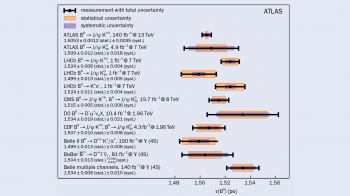
The 20th International Conference on B-Physics at Frontier Machines, Beauty 2023, was held in Clermont-Ferrand, France, from 3-7 July, hosted by the Laboratoire de Physique de Clermont (IN2P3/CNRS, Université Clermont Auvergne). It was the first in-person edition of the series since the pandemic, and attracted 75 participants from all over the world. The programme had 53 invited talks of which 13 were theoretical overviews. An important element was also the Young Scientist Forum, with 7 short presentations on recent results.
The key focus of the conference series is to review the latest results in heavy-flavour physics and discuss future directions. Heavy-flavour decays, in particular those of hadrons that contain b quarks, offer powerful probes of physics beyond the Standard Model (SM). Beauty 2023 took place 30 years after the opening meeting in the series. A dedicated session was devoted to reflections on the developments in flavour physics over this period, and also celebrating the life of Sheldon Stone, who passed away in October 2021. Sheldon was both an inspirational figure in flavour physics as a whole, a driving force behind the CLEO, BTeV and LHCb experiments, and a long-term supporter of the Beauty conference series.
LHC results
Many important results have emerged from the LHC since the last Beauty conference. One concerns the CP-violating parameter sin2β, for which measurements by the BaBar and Belle experiments at the start of the millennium marked the dawn of the modern flavour-physics era. LHCb has now measured sin2β with a precision better than any other experiment, to match its achievement for ϕs, the analogous parameter in Bs0 decays, where ATLAS and CMS have also made a major contribution. Continued improvements in the knowledge of these fundamental parameters will be vital in probing for other sources of CP violation beyond the SM.
Over the past decade, the community has been intrigued by strong hints of the breakdown of lepton-flavour universality, one of the guiding tenets of the SM, in B decays. Following a recent update from LHCb, it seems that lepton universality may remain a good symmetry, at least in the class of electroweak-penguin decays such as B→K(*)l+l–, where much of the excitement was focused (CERN Courier January/February 2023 p7). Nonetheless, there remain puzzles to be understood in this sector of flavour physics, and anomalies are emerging elsewhere. For example, non-leptonic decays of the kind Bs→ Ds +K– show intriguing patterns through CP-violation and decay-rate information.
The July conference was noteworthy as being a showcase for the first major results to emerge from the Belle II experiment. Belle II has now collected 362 fb-1 of integrated luminosity on the Υ(4S) resonance, which constitutes a dataset similar in size to that accumulated by BaBar and the original Belle experiment, and results were shown from early tranches of this sample. In some cases, these results already match or exceed in sensitivity and precision what was achieved at the first generation of B-factory experiments, or indeed elsewhere. These advances can be attributed to improved instrumentation and analysis techniques. For example, world-leading measurements of the lifetimes of several charm hadrons were presented, including the D0, D+, Ds+ and Λc+. Belle II and its accelerator, SuperKEKB, will emerge from a year-long shutdown in December with the goal to increase the dataset by a factor of 10-20 in the coming half decade.
Full of promise
The future experimental programme of flavour physics is full of promise. In addition to the upcoming riches expected from Belle II, an upgraded LHCb detector is being commissioned in order to collect significantly larger event samples over the coming decade. Upgrades to ATLAS and CMS will enhance these experiments’ capabilities in flavour physics during the High-Luminosity LHC era, for which a second upgrade to LHCb is also foreseen. Conference participants also learned of the exciting possibilities for flavour physics at the proposed future collider FCC-ee, where samples of several 1012 Z0 decays will open the door to ultra-precise measurements in an analysis environment much cleaner than at the LHC. These projects will be complemented by continued exploration of the kaon sector, and studies at the charm threshold for which a high-luminosity Super Tau Charm Factory is proposed in China.

The scientific programme of Beauty 2023 was complemented by outreach events in the city, including a `Pints of Science’ evening and a public lecture, as well as a variety of social events. These and the stimulating presentations made the conference a huge success, demonstrating that flavour remains a vibrant field and continues to be a key player in the search for new physics beyond the Standard Model.





